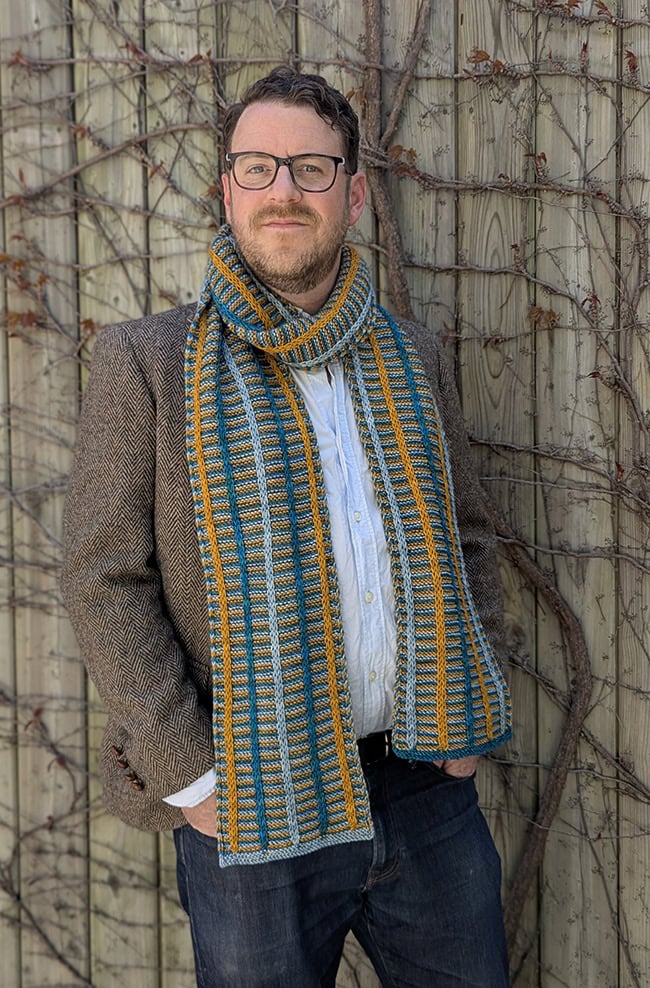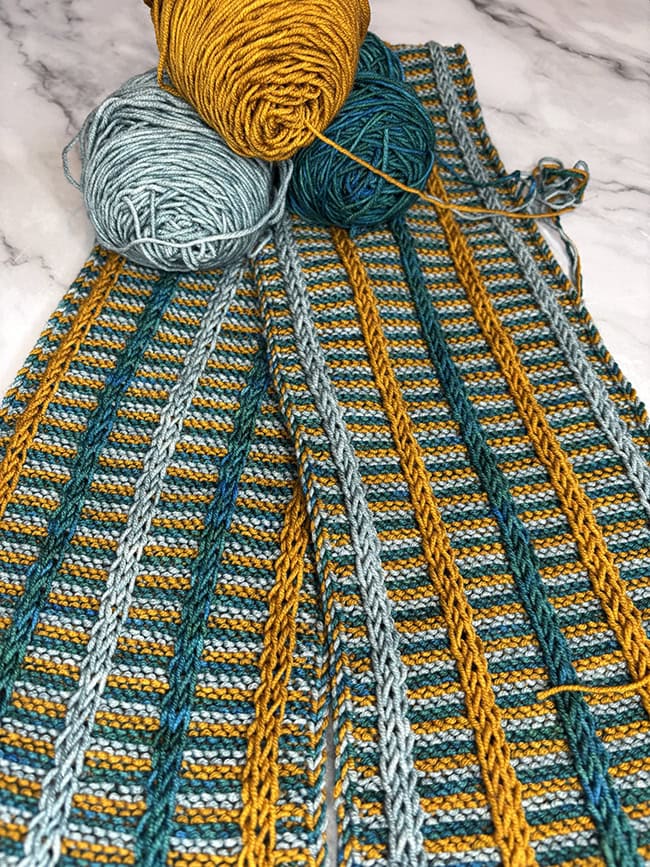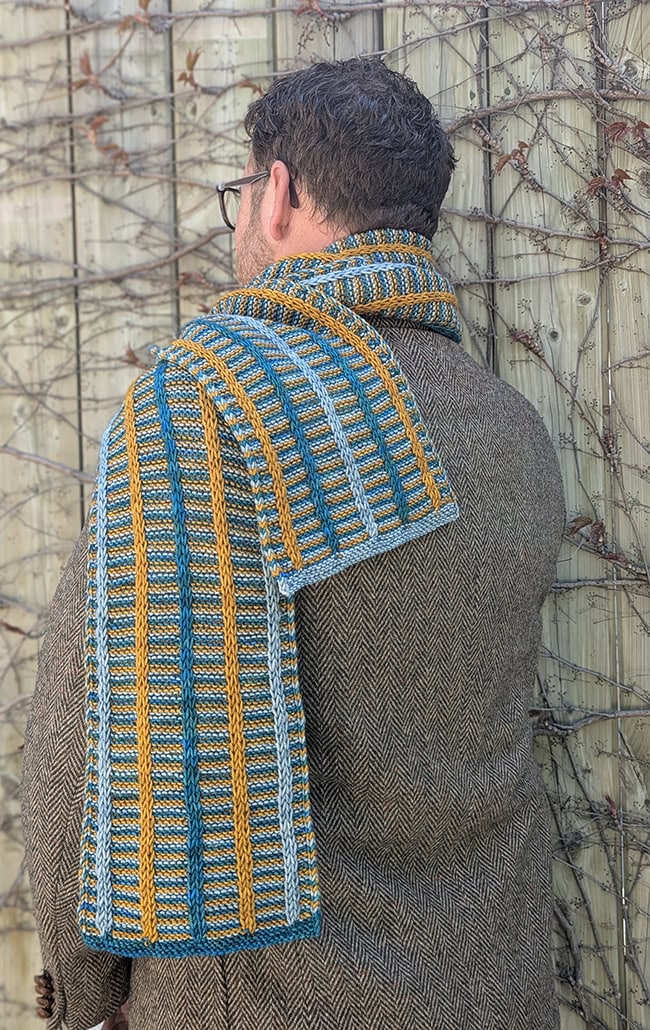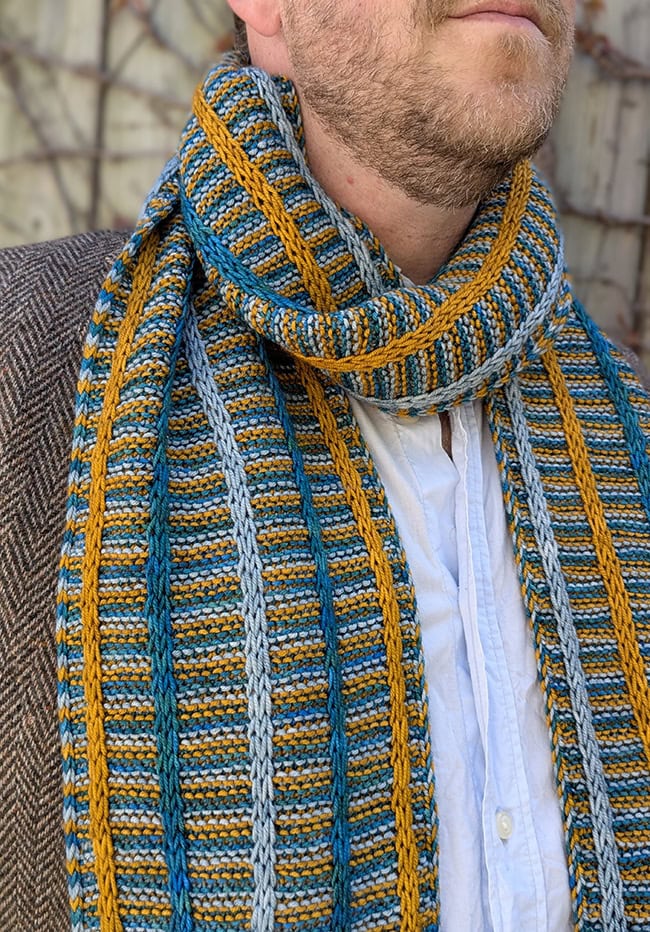Conditional Love, a free knitting pattern from Knitty.com.
INTRODUCTION
Conditional Love

by Mary Martin
![]()
The "IF" command is used extensively in computer programming to simplify complex tasks. This command specifies a condition; the program does one thing if the condition is met, and something else otherwise.
The Conditional Love Scarf uses a conditional knit stitch (Cond-K) and a conditional purl stitch (Cond-P). When working these stitches, look at the next stitch on your needle, if it's the same color as your working yarn you work it, otherwise you slip it.
Why do this? To create a 3 color, reversible scarf with a DIFFERENT color pattern on each side using the SAME stitch pattern for every row!
How is this possible? The conditional stitches extract the complexity from the row-by-row instructions of the pattern. Then you look at the stitches on your needles to determine how you work them.
This sounds strange! Does this make it easier? Can I do it? You follow conditional instructions every day. You stop at a red light and go on green. It feels automatic. These conditional stitches will feel automatic within a few rows.
The Conditional Love Scarf layers puffy tubes of color onto squishy 3 color garter stitch fabric. You'll throw this on every day for a joyful pop of color and delightful texture.
Gauge is not crucial for this project. Working at a different gauge will result in a different finished size, but the quality of the fabric should be the most important factor in deciding which needle size to use.
 model: Guy Crawford
model: Guy Crawford
 photos: Julie Crawford
photos: Julie Crawford
SIZE
One size; length adjustable
FINISHED MEASUREMENTS
At gauge given, sample measures
Width: 7.5 in / 19 cm
Length: 87 in/ 221 cm long
MATERIALS
Yarn
Marianated Yarns Playtime DK [100% Superwash Merino; 274 yd/ 250 m per 100g skein];
![]() [A] Tidal Pool; 1 skein
[A] Tidal Pool; 1 skein
![]() [B] Sting; 1 skein
[B] Sting; 1 skein
![]() [C] Hoth; 1 skein
[C] Hoth; 1 skein
Yarn Characteristics
![]() Choose a plied yarn with a tight twist in three solid colors.
Choose a plied yarn with a tight twist in three solid colors.
Recommended needle size
[always use a needle size that gives you the gauge listed below - every knitter's gauge is unique]
![]() US 6/4mm needles for working flat
US 6/4mm needles for working flat
Notions
![]() removable stitch marker
removable stitch marker
![]() tapestry needle
tapestry needle

GAUGE
22 sts/ 31 rows = 4 inches/10 cm in stocking stitch
PATTERN NOTES
[Knitty's list of standard abbreviations and techniques can be found here.]
Construction method: The starting edge is worked in Color A. The final edge is worked in Color C. The body of the scarf works one row each of Color A, B, and C, and then repeats.
Choosing Yarn Colors
When I find it difficult to choose 3 colors that contrast and coordinate, I turn to color sets offered by indie yarn dyers. They are the color experts! For example, Marianated Yarns offers a large selection of gradient sets. By choosing colors from a gradient set, I know the colors will look good together.
If choosing from a monochromatic gradient set, choosing non-adjacent colors will provide more contrast.
Yarn handling: If you are using circular needles and don't know from which end of the needle to start, slide your work to the end with 2 balls of yarn attached. Then look at the majority of stitches on your needle and choose the ball of yarn that is NOT this color to work this next row.
Techniques:
- Pattern Row: K2, (k3, Cond-K, Cond-P, k3) 5 times, sl2 wyif.
- Cond-K: If the color of your working yarn is the same color as the next stitch to be worked, k1 wrapping yarn twice around the needle, k1; otherwise, sl2 wyib. If you knitted the stitches, drop the extra wrap on the next row.
- Cond-P: if the color of your working yarn is the same color as the next stitch to be worked, p1 wrapping yarn twice around needle, p1; otherwise, sl2 wyif. If you purled the stitches, drop the extra wrap on the next row.
- Sl wyib/f: Slip 1 purlwise with yarn in back/front.
DIRECTIONS

Starting Edge:
Using A and any method, cast on 44 stitches.
Edge rows 1-4: K to last 2 sts, sl2 wyif.
With you work in position to start the next row, hang a removable stitch marker on the side facing you; this is Side 1.
Setup row 1 [Side 1]: K5, sl1 wyib, sl1 wyif, k6, kfb, sl1 wyif, k6, sl1 wyib, pfb, k6, kfb, sl1 wyif, k6, sl1 wyib, sl1 wyif, k3, sl2 wyif. 47 sts.
Setup row 2 [Side 2]: Join B. K5, sl1 wyib, pfb, k6, kfb, sl2 wyif, k6, sl2 wyib, sl1 wyif, k6, kfb, sl2 wyif, k6, sl1 wyib, pfb, k3, sl2 wyif. 51 sts.
Setup row 3 [Side 1]: Join C. K5, sl2 wyib, pfb, k6, sl2 wyib, sl2 wyif, k6, kfb, sl2 wyif, k6, sl2 wyib, sl2 wyif, k6, sl2 wyib, pfb, k3, sl2 wyif. 54 sts.
Body of Scarf:
Row 1: With yarn A, work Pattern Row.
Row 2: With yarn B, work Pattern Row.
Row 3: With yarn C, work Pattern Row.
Repeat Rows 1-3 to desired length or yarn is nearly used up, noting that final rows measure about an inch. Continue to the Top Edge after completing a Side 2 row with C. (Note: Side 1 has Color C as the middle stripe; Side 2 has Color A as the middle stripe).
Top Edge:
Decrease row 1 [Side 1]: With yarn A, K5, sl2 wyib, sl2 wyif, k6, k2tog, sl2 wyif, k6, sl2 wyib, p2tog, k6, k2tog, sl2 wyif, k6, sl2 wyib, sl2 wyif, k3, sl2 wyif. 51 sts. Cut A leaving a 6 in/15cm tail.
Decrease row 2 [Side 2]: With yarn B, K5, sl2 wyib, p2tog, k6, k2tog, sl1 wyif, k6, sl1 wyib, sl2 wyif, k6, k2tog, sl1 wyif, k6, sl2 wyib, p2tog, k3, sl2 wyif. 47 sts. Cut leaving a 6 in/15cm tail.
Decrease row 3 [Side 1]: With yarn C, K5, sl1 wyib, p2tog, k6, sl1 wyib, sl1 wyif, k6, k2tog, sl1 wyif, k6, sl1 wyib, sl1 wyif, k6, sl1 wyib, p2tog, k3, sl2 wyif. 44 sts.
Edge rows 1-4: K to last 2 sts, sl2 wyif.
Bind off. Cut leaving a 6 inch/15 cm tail.

FINISHING
Block by soaking the scarf in cold water. Squeeze out all the excess water between some towels. Lay it out and smooth the fabric with your hand and allow to dry. Weave in any ends.
ABOUT THE DESIGNER
 Mary Martin works on innovative knitting techniques. She creates reversible designs using slipped stitches with Fission & Fusion Knitting.
Mary Martin works on innovative knitting techniques. She creates reversible designs using slipped stitches with Fission & Fusion Knitting.
Mary is exploring the use of conditional stitches in her Woven Knitting designs. She hopes to express knitting patterns with complex woven motifs with the elegance and conciseness weavers use to describe their weave structures.
See MaryWMartinKnits.com to learn about Fission, Fusion & Woven Knitting.
Pattern & images © 2025 Mary Martin










